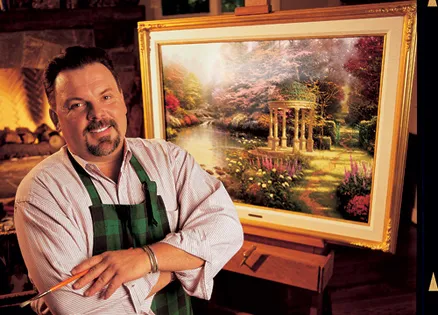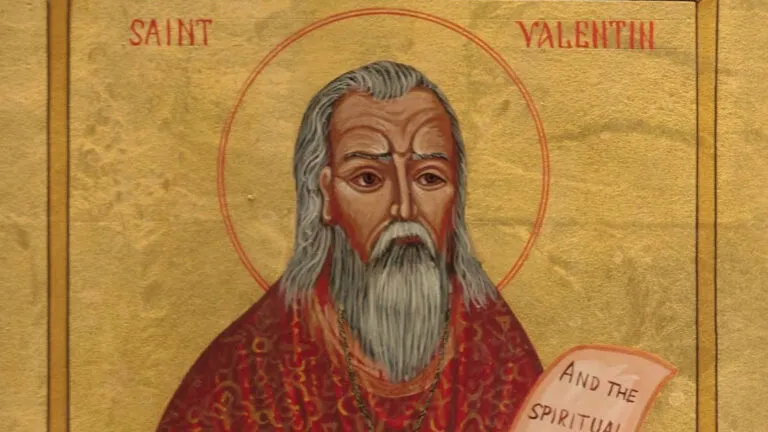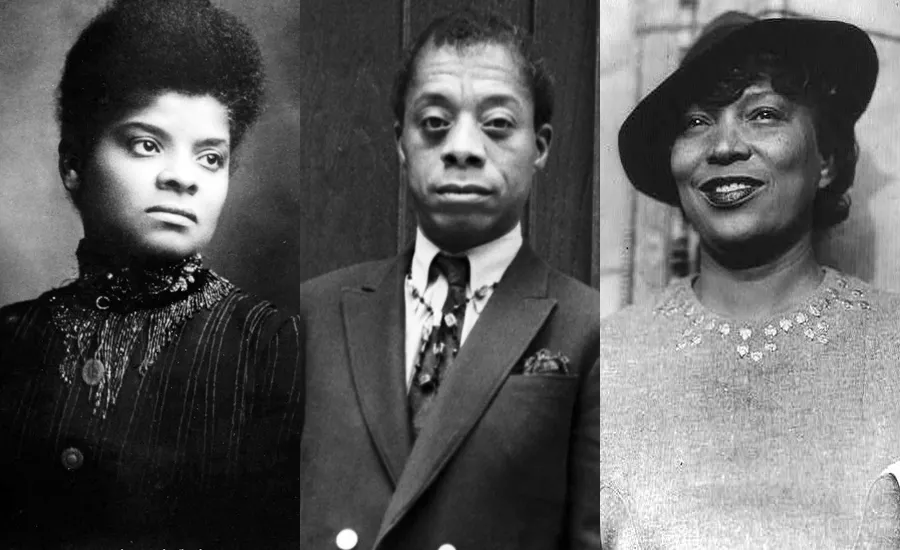One afternoon, early in my career, I attended a showing of my work in a small gallery in northern California.
Among the people who stopped by to see my paintings, there was a man who wandered in off the street, saw the brightly lit artwork (as well as the complimentary hors d'oeuvres!) and decided to stroll around the show. After making his rounds, he pulled up beside me.
"So," he said, "why does this Kinkade guy have all the lights on in his paintings?"
"I couldn't tell you," I confessed.
"Well, if you see him," said the man, "ask him for me."
In a sense, I have spent my career trying to answer that question.
When I was a child, I would come home after school and our house would often stand empty, dark and cold. I'd hope, as I approached, that the lights would come on suddenly—that someone would swing open the door and wave and smile as I quickened my step.
I could hope, but I knew that no one would be home. My father had left us when I was little, so my mother worked late as a secretary to support the family. My brother and sisters frequently got home from school after I did.
I would scuff my heels along the sidewalks beside shadowy hedges and sycamore trees. I would stop and study a bird's nest or some wildflowers or perhaps the way wood smoke curled out of chimneys on cool days, but mostly I'd look at all the other houses I passed, the lights on in their windows, the brightness so inviting I wanted to dash up and ring the bell and wait to be offered some cookies and warm cinnamon milk.
When I finally reached my house, I was hesitant to open the door and go in. It was more than just being afraid of the dark. The lights within other houses on our street filled me with longing. I wished the whole world could be lit up like those houses. Even as a latchkey kid, I was a bit of a romantic.
By no means would I describe my childhood as a miserable one. Nothing could be further from the truth: In the foothills of the California Sierras, in the small town of Placerville, we Kinkade children—I, my older sisters and younger brother—enjoyed a blessed upbringing.
My brother and I made a tree house in our backyard and rolled go-carts down our drive. We would attend services at a country church down the lane from our house, the Kinkade clan taking up the length of a pew.
I would sit mesmerized not by the voice from the pulpit, but by the blue glass windows overhead and flickering yellow lights of the candles at the altar.
The Placerville of 35 years ago was an innocent place and time, the kind of town where we could ride our bikes to Main Street for a haircut and a bag of dime-store popcorn without our mother worrying, where a boy could deliver the local paper to the door of a pretty girl who would one day become his wife.
And it was a place where a boy could have his dream of becoming a painter nourished, his ever-supportive mother framing his drawings on the living room wall, right next to inexpensive prints by his heroes, Norman Rockwell and Rembrandt.
After high school, I took all my romantic aspirations and small-town innocence with me to the University of California at Berkeley. I wanted to become an artist of the people, a communicator with paint, the next Norman Rockwell.
I had a desire to touch people's lives with my paintings, and I believed that if I could be true to myself, if I could express my feelings and paint from my heart, my work would speak to people. Why else would I want to paint but to share the joy and light I felt inside with others?
Talk about culture shock! My homespun values were about to clash with twentieth-century intellectualism. No one at Berkeley seemed to find much merit in my idealistic approach. People were creating art around dark or pessimistic themes, exploring tortured inner feelings, childhood pain and personal insecurities.
My fellow students urged me to get in touch with inner demons. My paintings were deemed clichéd and sentimental and outdated.
I suppose I should be grateful for that period of my life, for the way my beliefs were tested. But at the time, each class hour felt like a blow to the stomach, my professors all fighting to tear down my idealism. To them, artwork was supposed to shock and disturb the viewer, not provide comfort and joy.
In my dorm room at night, I would lie awake, plagued by doubts. I worried that my professors had it right, that my vision was naive and simplistic. The light began to fade from my dream.
By the end of the year, I gave up on the art program altogether and switched to the College of Liberal Arts, studying literature and humanities. With each spare hour I had, I painted alone in a basement studio and did illustrations for a local newspaper, but every day was a struggle to discover how I could ever become the painter I'd vowed to be.
I'd pray for counsel, but didn't have any answer besides quietly painting and drawing and keeping my creative flame alive through work and hope. Then one day a friend asked me to a revival meeting and, to my surprise, I said yes.
I was 22 years old and I'd not gone to church regularly since I'd left home. I remembered the lights and glass and burning candles of my hometown chapel. Maybe the smell of a church would lift my spirits.
But the auditorium was dark and uninviting, part of an abandoned college, and I wondered what good could come out of a place as dreary as this. With its faded drapes and dusty windows, I couldn't see the slightest promise of light in the place.
As the enthusiastic young preacher's voice rose and his words, like a long-lost lifeblood, reached my heart, I felt something good within me stir. It was like the feeling I once got looking at a house all ablaze with the warmth of light, as if I at last had found home.
"God's in the room," the preacher was saying. "He's waiting to touch your life, to meet your every need, to fill your life with light. He's here. If you want to know him, come down to the altar. Come down to the altar now."
Without consciously willing it, I was suddenly rising and making my way down the aisle to the preacher, his words entering me like light enters glass. At the front of the auditorium, I found myself kneeling.
Open the doors, I was praying. Open the doors you want me to go through, God. I commit whatever talents I have to you. If there is any way you want to use me, please show me the direction clearly, dear God.
I felt myself filled with what I'd always wanted to fill my canvases with, felt lifted out of the dark morass of confusion. I sensed a freedom I'd never known before, freedom to paint as I had always wanted to. And from that day, it has been my life's mission to fulfill that dream of light and bring it to people.
I finished out Berkeley and went on to the Art Center College of Design in Pasadena, where some of my teachers did encourage my traditional approach. Along the way I seemed to be living out the cliché of the starving artist—working late into each evening and scrimping for art materials and tuition.
I tell you, those years were lean, but things were also falling into place for me.
A fellow artist, James Gurney, and I ended up traveling across America after two years at Art Center. We were, as the newspapers called us, two young "hobo artists."
In the process of working and traveling, we came up with the idea for a sketcher's handbook and hit New York with a book proposal in hand. The Artist's Guide to Sketching came to life and became an art instruction success by the time I was 24 years old.
In 1982, I married my childhood sweetheart, Nanette, and we returned home to Placerville, not far from where I'd first seen her on my paper route. My paintings soon started to sell. In fact, I couldn't keep up with the demand.
To reach more people, Nanette and I experimented with ways my work could be reproduced, including a process in which the print's inked image can be bonded with artist's canvas. With a few touches by trained artisans, the reproduced work on canvas had all of the appearance and texture and warmth of an original oil painting.
To convey hope and joy to others, the scenes I paint are alive with light. Each canvas is infused with brightness, because I believe this is how the world can be and sometimes is. A lighted window says home to me. It says all is well with the world, someone's waiting, someone cares.
Most of all, light exists in the dimension of the spirit. It was what God first created and is probably the most consistent metaphor in all of Scripture. Truth is represented as light, and in one bible passage, Christ affirms that each of us should "Let your light so shine before men, that they may see your good works, and glorify your Father which is in heaven."
But light is something you can't hold. You can't touch or taste or pin down its subtle, constantly changing effects. As a painter, light is the essence of what I try to capture on canvas—a light that dispels darkness, that chases away confusion and despair.
However, for me, the brightest light burns inwardly. With this supernatural, inspiring light, God illuminates our spiritual path and leads us to heaven through the love of his son. And heaven, at least in my artistic imagination, is a place where the windows always glow.
Download your FREE ebook, Creativity and Personal Growth: 7 Inspiring Stories On How Crafts Can Change Your Life





